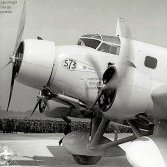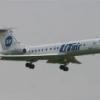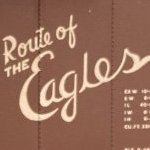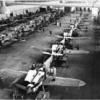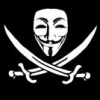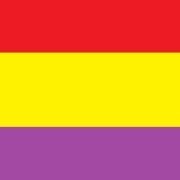Search the Community
Showing results for tags 'SCW'.
-
Now that I have your attention 😉 my entry will be this lovely Italian biplane which will be in the markings of the leading Spanish Nationalist ace Garcia Morato. Box and contents. Note in the bottom right hand corner the prop broken on the sprue. The spinner is loose in the box. First thing to do is fix the prop. I did this by simply cementing the spinner back on to the blades using the sprue as a jig. Next thing, following @jean’s lead was to fill the deep panel lines on the fuselage. I used sprue gloop. Thanks for looking. AW
- 25 replies
-
- 15
-

-
- 1/72
- Supermodel
-
(and 1 more)
Tagged with:
-
Dear all, As requested by Jerzy (JWM), I herewith post some images of the Roden Heinkel He 111B I built a few years ago. Markings are mostly from the kit, although I swapped the white fuselage numbers for black ones, as they should have been. The trick I used to get the fuselage to close, was to add a shim (1.5 mm behind the cockpit, 0 mm at the tail), which allows the clear parts and the bomb rack to fit). I kept weathering rather light, just adding a pin wash to the control surfaces, the tank filler caps and the bomb bay. Certainly not my best result, but in the end I was just glad to have finished it. I do like the elegant look though of the 'classic' bomber nose, rather than the later 'all glass' nose from the P and H versions. Peter
- 23 replies
-
- 54
-

-

-
Hi, CASA factory was building under licence early variant of Vickers Vildebeest with Hispano Suiza V-engine (Vickers type 245, whereas Vildebeest Mk I is type 244 and Mk II is type 258 as given in instuction for model by Special Hobby). 25 of them were produced in Getafa (Spain) with exchangeable wheel/float u/c. I build this model with GB "Britts abroad". Model presents machine with serial T-17, blonging to Grupo 72 Defensa de Costas in 1938, based close to Barcelona. I have painted in my interpretation of her scheme, which is know only from this photo. Please note that floats for sure has three colours patterns whereas fiselage rather only two... Therfore I did not agree with interpretation from Molina-Mercado book followed by SH instruction, or Here is my model : I have introduced some changies to kit during build - here is thread from build (this Vickers plus two other machines) Comments welcome Regards Jerzy-Wojtek
-
Hello everyone... This is build #1 for me here in the group build. I will be Using Heller’s great little Bf.109B/C to build a plane operating in Spain by Hptm. Werner Mölders while flying with the condor legion. Here you can see the original decals of which I will attempt to use some. If they fail I will fall back on these AML Decals. Mölders plane is the overall RLM 63 grey/green over 65it is the one on the right marked 6•79 with the red spinner. If something goes horribly wrong I will Fall back to my second option on the left. Hptm. Haro Harder marked 6•36 in the standard splinter scheme of 70/71/65. Rest assured I do have the canopy its under the decal booklet in the decal photo above. Please feel free to ask questions, post comments, and or add thoughts. Build # 2 will be a Hawk 75. Dennis
- 41 replies
-
- 10
-

-
- Bf.109D
- Legion Condor
-
(and 1 more)
Tagged with:
-
Seeing as this is the Helicopter and Gyrocopter GB I though I would enter with both a helicopter and also an autogryro. And as I have 2 Cierva C30's I might as well build two at once! So we have Merlin Models plastic and white metal kit and Azur plastic and resin kit - building two at once - yeah that will make sense when we have a few different model materials! Also to incorporate into one of the kits will be the Aeroclub engine. I am a big fan of Spanish Civil War aircraft so one will be the Republican machine shown and not sure what the other will be. British civil is a posibility - cant beat the colours from the1930's Obligatory sprue/box shots. Not much to either kit really especially the Merlin version. Its smaller than you might imagine but sure two decent models can be made from what we have here. Comparing the two kits.... staple through the fuselage.... painful! Did I say the Merlin Models kit was basic???? Azur -close up camera shot never looks good. Decal options from Azur. I normally paint the 3 colours on the tail of any SCW aircraft, as its easier than trying to wrapping decals around a tail.... Hoping these kits will be something different. Will be making them alongside my other GB entry the Mil-4 Hound.
- 29 replies
-
- 10
-

-
- Cierva C30
- SCW
-
(and 1 more)
Tagged with:
-

Spanish Civil war or early war Junkers Ju-86
Corsairfoxfouruncle posted a topic in Aircraft Interwar
Hello all ... I recieved this for Christmas from my Brother in law. It has markings for the Spanish civil war. Anyone have any info on the type during the SCW, or maybe a place where i can find some info online, asking @Artie ? Books do me no good as i haven't any room for a library at the moment. Dennis- 12 replies
-
- SCW
- Junkers 86
-
(and 1 more)
Tagged with:
-
I just received my copy of ‘German Eagles in Spanish Skies’ by David Johnston. Wonderful coverage of the early prototype Bf109’s up to the 109E ‘s in Spain. I’ve been collecting books on the SCW aircraft for 40+ years and have to say 90% of those shown in this book are new to me. Lots of information on the transformation from the early silver-gray color to the European colors and even one 109B with a solid light fuselage with splinter camouflaged wings. Pilot interviews, lots of technical drawings as well. Charlie
-
What is it, masochism, stupidity, senility?? After all of the complaining I did about the AMG Bf 109 A build of a few months ago one might think I would never touch another AMG 109 again. Well, the farther that model progressed the more I grew to like the kit. Sure, it had its fair share of fit problems and really, really stupid engineering, but the final product looked the part and it is by far the best Jumo powered 109 available. This time, I decided to go beyond "out of the box", but there actually isn't very much needed. The kit includes a Nice photo-etch fret with seat belts, landing gear covers and cockpit details; but more of that later. Initially I wanted to add the very nice Aires cockpit as seen in this photo, but the more I looked at it the less I decided it was needed. The molded-on map case must be removed from the left side of the cockpit and reconstructed on the right. This was done by folding some .005" plastic card using a photo-etch bending tool. This is much easier than making it from sheet brass; it can be cut with a razor blade and obviously glued with regular glue. The main addition to the cockpit is a Yahu instrument panel. These things are little works of art and really can't be appreciated without magnification. This one was intended for a 109 E, but given the fact that the cockpit is pretty much invisible in this scale, I'll try to get away with it. [/url] The rest of the cockpit need only some scrap plastic and detail painting. Instead of using the kit's photo-etched seat belts, I opted for the new steel pre-painted belts from Eduard. These things are magnificent. I can remember threading painted paper through individual etched buckles. In 1/72nd this was a challenge. These new belts are very thin, incorporate buckles, and can bet realistically draped.I added some burnt umber oil wash and was done. Here is the cockpit just before closing up the fuselage. Curiously, this time I had no trouble with the cockpit being too wide. The fuselage halves mated up perfectly. There is one trick to attaching the wings. As you can see in the photo, there is a "tab and slot" affair at the trailing edge. This is intended purely to frustrate the dickens out of the builder. There is absolutely no reason to complicate the assembly intros manner. I cut off the tab and a section of the wing root as seen here. This piece contains both the lower and upper wing root areas. The wing now fits (kind of) and after cleaning up, the small piece fits nicely once the wing has been attached to the fuselage. Attaching the cowling panels hasn't gotten any easier, but at least I now know what to expect. First, position the lower wing on the fuselage. This contains the lower cowl and forms a base for the next step, attaching the exhaust panels. Once these have set up, the cowl panels directly above them are taped in place and progressively glued. As you can see in these photos, most of the airframe has been riveted using various Rosie the Riveters. Another change this time was the the process of glueing the photo-etch radiator grill to its plastic base. To make life (much) easier, I sanded the base totally flat, positioned the grill, then flooded it with Tamiya Extra Thin Cement. I wondered whether it would still separate during sanding and shaping, but the Tamiya glue effectively welded it in place. There was still plenty of definition for dry-brushing to highlight the grill. There was a bit of sanding required, but by thinking the plastic part, this was easier than the last time. Further progressing along, here the nose has been filled and primed: ...then rescribed and riveted: Another change from the last model was the use of a vac canopy. After quite a bit of trial and error, the Squadron (Falcon) canopy proved to be the best fit. I returned to a familiar method of making brake lines, True Details .007" coated wire. In the past I have used sections of stretched plastic Q-tip tubes for guides, but .3mm Albion Alloys brass tubing works much better, and when glued in place, stays in place. Another piece requiring a minor adjustment is the spinner. The prop cutouts are just a bit too large, leaving a gap when the base plate is attached. A strip of .005" card was glued in place, then the joint was filled in with very thin superglue. Once sanded things fit very well. At this point everything is buttoned up and ready for paint. The white rudder and wingtips have been done...now the fun begins. This aircraft, 6 O 51, is one of about three very oddly painted early 109s used in the Spanish Civil War. Instead of the common RLM 65/63 or even 65/70/7, it had three upper surface colors. Initially I thought it was just a partial overpaint of RLM 63 over the delivery scheme of 70/71. But after the urging of a knowledgable friend, I studied the photos for some time. The contrast was just too great for the greens, so the natural conclusion was 61/62/63 on top and 65 underneath. There was something curious about the starboard stab though. The lighter color looked lighter than RLM 63 and the darker one was darker than RLM 61. So I lighted up the 63 with white and used RLM 70 for the other. So far so good. I went to my Gunge Sangyo (say it with me...God's Paint) stash and realized that I didn't have what I needed. A quick email to Libor Jekl, a reading of the Special Hobby SCW JU 87 A, and a review of a 109 F that I posted on Hyperscale years ago, gave me a close enough set of mixes. Also my non-red/green color blind wife confirmed the matches. Then came the issue of hard vs. soft edges. The photos three available photos of this plane are inconclusive. The best of them seems to show a fuzzy demarcation but then you realize that the whole photo is fuzzy. There is an excellent shot of a sister 109, 6 O 55, that clearly shows a hard edge camo. And since virtually every other plane with these colors has a hard demarcation, I went with that. Color RLM 63 applied and masked: Then 61/62 and the other two colors on the stab. Over the past few days I applied the decals, gloss coat, oil washes, another gloss coat and Gunze 182 flat. Whew; that was a mouthful. More soon.
- 22 replies
-
- 24
-

-

-
Starting to plan the paint for a Ju 52 in SCW period. I have the Owl decals, and am using a 1/72 Heller kit as the basis. I plan on doing 22*101. https://eshop.owl-czech.eu/detail/1-72-ju-52-spanish-transport/ I have not been able to find a photograph of the specific airplane. The Owl instructions seem to indicate RLM 63, but I wonder if L40/52 would be a better match? I've checked the the M. Ullmann book as a reference, without much joy. Any assistance or help much appreciated. KE
-
Dear all, Please find below some images of my Airco DH.9 Hispano Suiza from the Aviación Militar, on the eve of the Spanish Civil War. For this conversion I used the Classic Plane vacuform fuselage for the DH9, with a modified nose and upper front fuselage, combined with the wings, tail plane and undercarriage of the Airfix DH.4. The Roundels came from a Loire 46, the crow and tail number were custom printed by Arctic Decals I finished it already last year, but didn't have any decent photos until recently (Thanks LJ). I hope you like it Peter
- 12 replies
-
- 31
-

-
Hi all, would anyone have any reference material for the Opel Blitz being used in the SCW, would these have been painted in the early three tone camouflage or the generic field grey/green? Also the kit I'm planning on using would be: https://www.scalemates.com/kits/181439-icm-35401-typ-2-5-32-1-5to I know they were used quite widely by the Condor Legion but information is a little scarce
- 2 replies
-
- scw
- opel blitz
-
(and 1 more)
Tagged with:
-
This is the 1/72 Azur short run release of the Cierva C.30 Autogiro. A curious looking aircraft which is unlikely to have seen use during the war, there were a few in the Spanish Air force before the war broke out but their fate is unknown. The kit is what you would expect from Azur and didn’t cause any problems, it is best to take your time around the under carriage at the front as its very delicate, I also had a slight issue with the rotor blades as the resin part in the middle was damaged, I replaced those parts with stiff wire. I finished the model in Mr Metal aluminium buff-able metallizer, with details painted in Tamiya acrylics. I used the kit decals but I think the markings are fictitious.
- 12 replies
-
- 22
-

-
Pz.Kpfw.I Ausf.A Spanish Foreign Legion, Granadella 1938. This vehicle is ‘214’ from the Spanish Foreign Legion Tank Brigade, 2nd Company, 1st Battalion, 1st Platoon. This machine was based in Grandella in the province of Alicante in 1938. The Panzer 1 was a very light armoured and under gunned tank even for the 1930’s, it was best suited to a role of infantry support as it was inadequate against other tanks. Dragon’s Pz.Kpfw.I Ausf.A is a great little kit, I found no fit issues and enjoyed the simplicity of the build, the etch exhaust shrouds are supplied in the box as well as the option to open all of the vision slits. Individual tracks are supplied in the form of Magic Tracks which are already cleaned and separated from the sprue. There is also a boxing with a full interior included. The three tone camouflage was mixed with Tamiya acrylics to eye as the references for these early colours are a little vague. I used decals from Star Decals and masked the air recognition markings on the roof with MR Paint black & white.
- 6 replies
-
- 7
-

-
- scw
- condor legion
-
(and 1 more)
Tagged with:
-
The Boeing 281 was the export version of the Boeing P26 Peashooter and was most notably used in China during the late 1930’s. Not so well known is the single aircraft that featured over the skies of Spain during the Civil War and although it was only one machine it did seem to strike a chord with the republican forces and this lead to the nickname “Boeing” being given to the more numerous Polikarpov I 16 due to its similar shape (from a distance) and it also being a monoplane which was a rare thing at the time. The Spanish Model 281 was bought after its demonstration at Barajas airfield on March 10, 1935 where it stayed until the war broke out. From there it flew to Cuatro Ventos airfield in the Summer of 1936. In October of 1936 it was operating from Getafe when it was shot down in a dogfight with three Fiat CR.32s. I decided to model my Peashooter with the olive drab fuselage and trainer yellow on the wings and tail. I added red banding to the wings and fuselage and printed my own decals for the roundels on the wings and the Boeing logo and serial number on the tail. I used an etch set from Brengun which improved the cockpit and a few parts from the Pavla set, a Yahu instrument panel was also used in this build. This has been a very enjoyable project and I’m very pleased with the result. I would highly recommend the kit and the after market parts used caused no problems either. To see the build log on my site please look here: Peashooter Build Log
- 20 replies
-
- 37
-

-
Hi All I have a build log currently running on my blog and I figured I may as well post it here for you to look at, its my first major 1/32 build and I'm really enjoying the bigger scale! In this build log I’ll be building the Trumpeter 1/32 Ju-87A-1 ‘Anton’ and I’ll be adding the Eduard Big Ed set BIG3351 along with Montex K32296 Mask set for 29-5 from the VJ/88 experimental group in Spain 1937. For reference I’m using Hikoki Publications Condor by Patrick Laureau and Military Illustrated Modeller 073 which has an in depth build of this kit by James Hatch. Work begins, unusually, with the engine front cowling and propeller. I opted to leave the propeller until later. Eduard provide the correct horizontal slats for the ‘A’ model, these simply stick over the top of the kit part. The engine and radiator are very well detailed and its a shame that so much will be hidden, the work needed to open up the hatches is far in excess of what I’d like to tackle so it will have to be closed up. There are various scoops and intakes which show a little of the engine so it is nice to have it there. Next its on to the cowling and front of the fuselage and straight off there are a few gaps showing themselves in the test fitting stage. Also a well documented problem is the amount to which the exhausts protrude from the the side of cowl. Without modification they are flush but reference shows that they should protrude quite a bit so I went about thinning the inside until I had the desired effect. Also at this point I fixed the scoops on the underside of the cowl so that they had the correct rounded gouge in the panel which they dont have straight from the box. In test fitting the engine, radiator and bomb cradle into the cowl I found that its quite a tight fit so you need to ensure that everything is aligned properly before gluing. The radiator attachment to the bottom of the engine is a little flimsy too so care needs to be taken throughout this stage. It is worth pointing out that I glued the exhausts onto the inside of cowl instead of to the engine. This meant for a more secure join and gave me the maximum protrusion. Now to get this lot together and then onto the cockpit.
- 1 reply
-
- 1/32
- Stuka Anton
-
(and 1 more)
Tagged with:
-
Another one off the production line.... Polikarpov I-16, Type 10, 1. Squadron, Lina Base, Spain, April 1938. The kit is somewhat daunting when you're first presented with the sprues and care will be needed throughout the build, there are no major problems it's just a bit of an old school build, meaning filler on every join and wing roots with a large gap etc. I used super glue as a filler which worked quite well, the few panel lines were then re-scribed and I added a few rivets around the engine cowling. The cockpit is sparse, as the real thing and you can't really see anything other than the chair. Seatbelts are supplied in etch metal and resin exhausts are included. For the silver ring on the cowling I used a thin strip of foil tape which works from stand off scale but would have been better painted. Painting was quite straightforward and done in a day with MRP standard soviet colours from WW2. There are decals for the fin but I chose to paint this instead, the rest of the decals are nice, maybe slightly thick for the scale. For finishing I used a different method by buffing the paint back with a cloth and sanding sticks, then I rubbed pigments lightly all over the airframe to give a dusty look. I'm trying to get a bit of realism from my larger models and I've started experimenting with techniques such as not having dead straight lines on paint finishes, building in imperfections in the finish and trying not to use the conversational gloss coat, matt coat etc. and instead buff the paint back with a cloth and fine sanding sticks. I would have preferred paint masks for the markings on this build so I may move to that for future builds over 1/48. Anyway hope you can see what I'm trying to achieve Kit: Azur Polikarpov I-16, Type 10, Super Mosca Scale: 1/32 Built: OOB Paints used: MRP RLM 62, MRP-024 A II G Light Blue, Xf 7, MRP White, MRP Black, Xf 58 Weathering: Mig pigments European Earth, Desert Sand, Flory Dark Dirt Wash
- 5 replies
-
- 13
-

-
- 1/32
- Polikarpov
-
(and 1 more)
Tagged with:
-
Hi, A single Messerschmitt M 35 b, initially as EC-BDB then 30-73 was in Spain during Civil War. There is a side colour profile for it on wing palette - but - is there any photo of this machine? I almost finished model (Huma 1/72 - soon on RFI) of her but I have doubts especially on look of upper (and bottom?) sides of wings. Perhaps there should be some black strips or white crosses - the profile is not suggesting them... I've googled many hours iincluding Aeronet etc - without success, but I have feeling that I've seen once (?) a photo of her. Can anybody help? Cheers Jerzy-Wojtek
- 4 replies
-
- Messerschmitt M 35 b
- Spanish Civil War
-
(and 2 more)
Tagged with:

Wedge-TailedEaglePortraitRaptorDomains.thumb.jpg.41a306d3445a68f0f2df773e01776ea6.jpg)
